Several readers have said recently that they’d like to see occasional images from my archives. These American Kestrel photos are my attempt to deliver on that request. Most were taken at Farmington between 2009 and 2012 and I don’t believe I’ve posted any of them before though I have posted other images of a couple of these birds.
At the last minute I noticed that all but one of them are males. I’ll make up for that shortsightedness in the future because I believe the females to be every bit as appealing as the males in their own more subtle way.
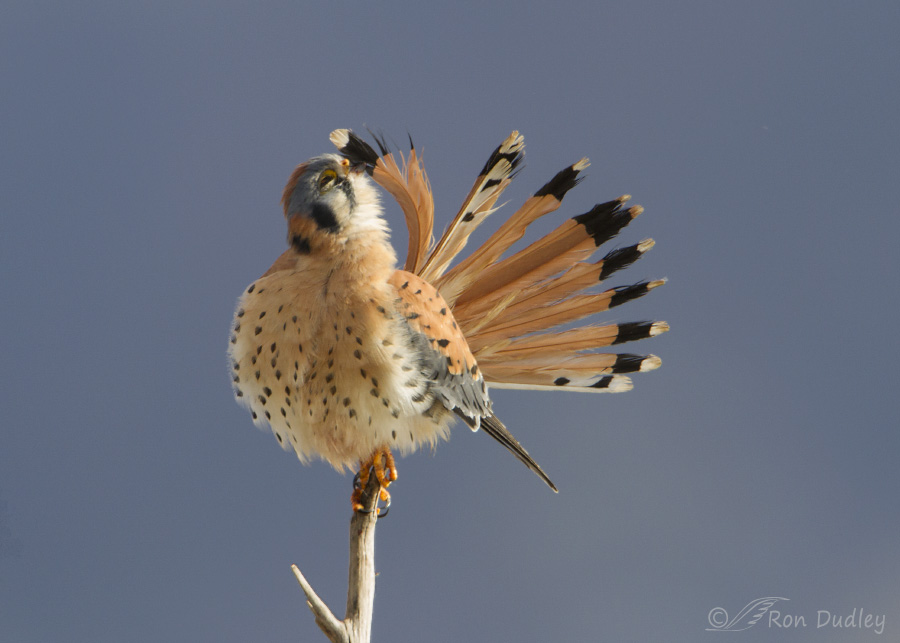
1/1000, f/7.1, ISO 640, Canon 7D, Canon EF 500mm f/4L IS USM + 1.4 tc, not baited, set up or called in
This male posed for me for a very long time as he preened on one of the favorite kestrel perches at Farmington (sadly this perch is gone now). I was seldom able to get a look at his eye (or a catch light) during this session but I think the pose and behavior partially atone for that.
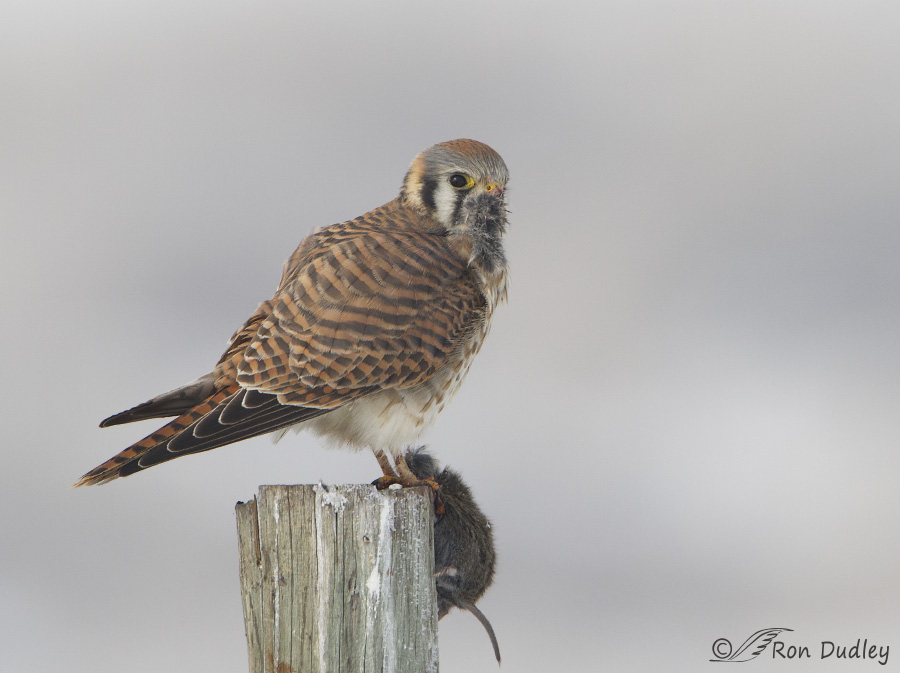
1/1600, f/8, ISO 800, Canon 7D, Canon EF 500mm f/4L IS USM + 1.4 tc, not baited, set up or called in
This female was feeding on a vole on a cold, snowy morning. I like the surprised, “pretending to be innocent” look on her face, as if she’d been caught with her hand in the cookie jar.
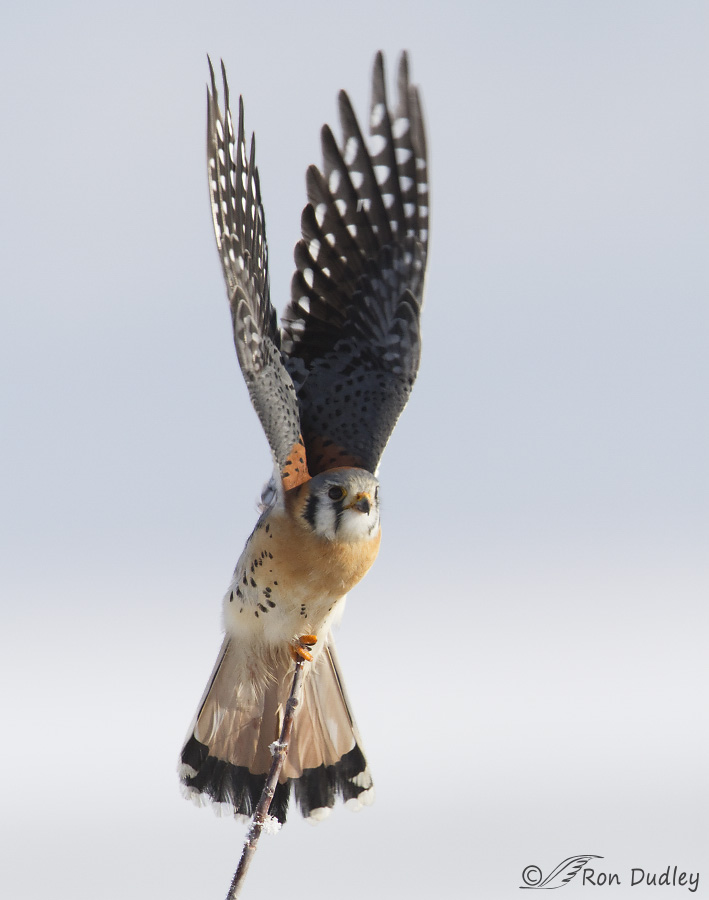
1/2000, f/7.1, ISO 400, Canon 7D, Canon EF 500mm f/4L IS USM + 1.4 tc, not baited, set up or called in
For me the primary appeal of this image is the unusual wing position. I don’t think I’ve ever photographed kestrel wings held higher than this at takeoff.
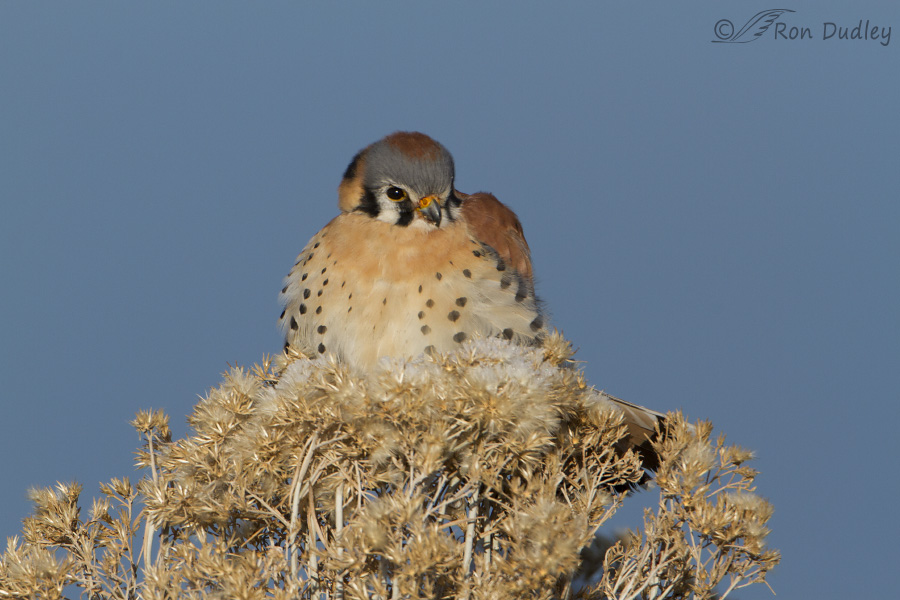
1/1600, f/10, ISO 500, Canon 7D, Canon EF 500mm f/4L IS USM + 1.4 tc, not baited, set up or called in
This bird was fluffed up and nestled down in rabbitbrush on a very cold morning along the Antelope Island causeway. To me he almost looks cuddly. The image is full frame.
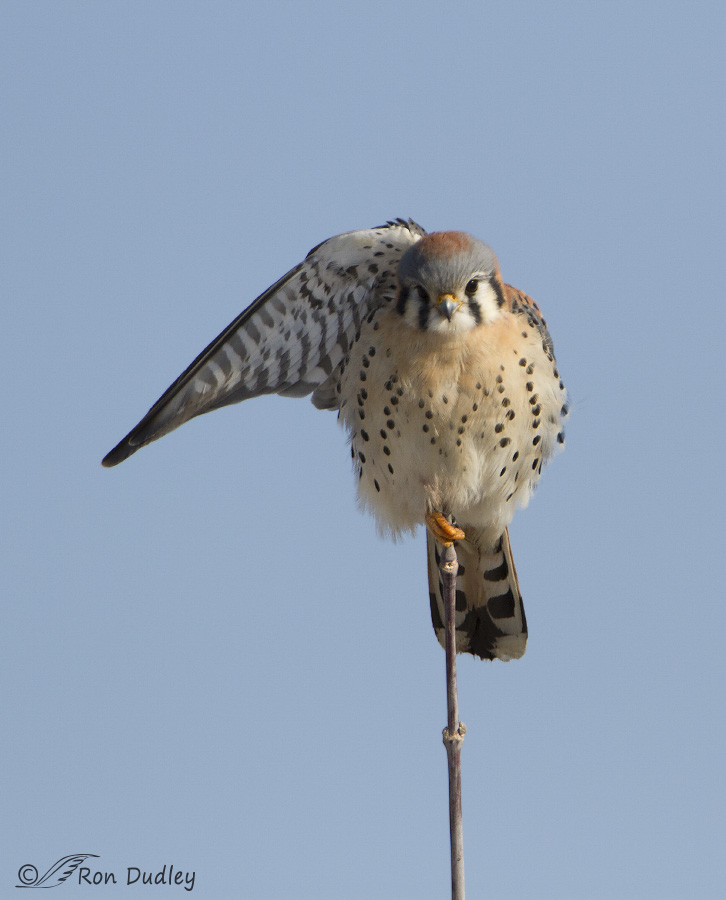
1/2500, f/7.1, ISO 500, Canon 7D, Canon EF 500mm f/4L IS USM + 1.4 tc, not baited, set up or called in
A “one-armed” wing stretch.
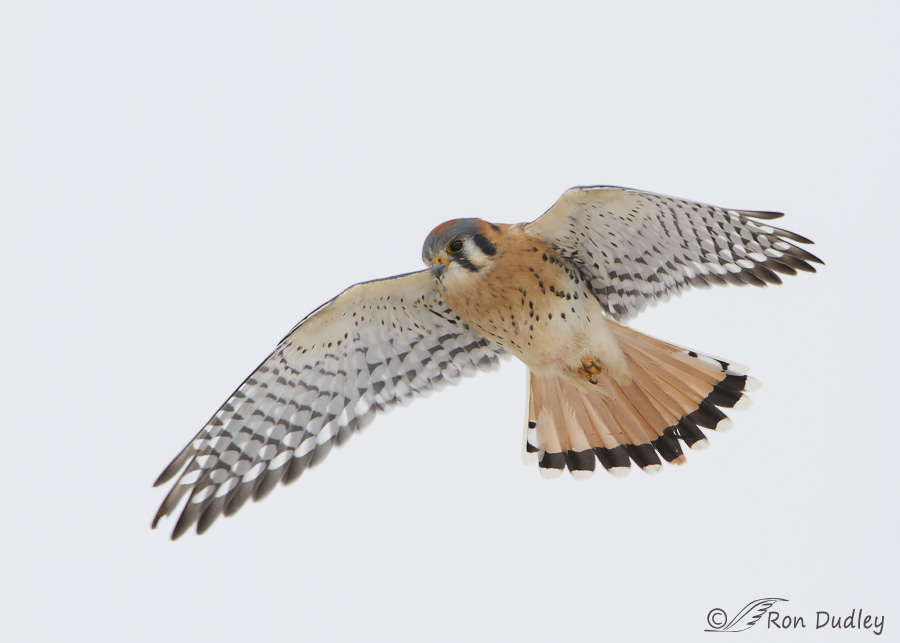
1/2500, f/7.1, ISO 500, Canon 7D, Canon EF 500mm f/4L IS USM + 1.4 tc, not baited, set up or called in
High key images aren’t at the top of my list of favorite types of photos but it isn’t often that I catch a kestrel in flight. This shot is nearly full frame.
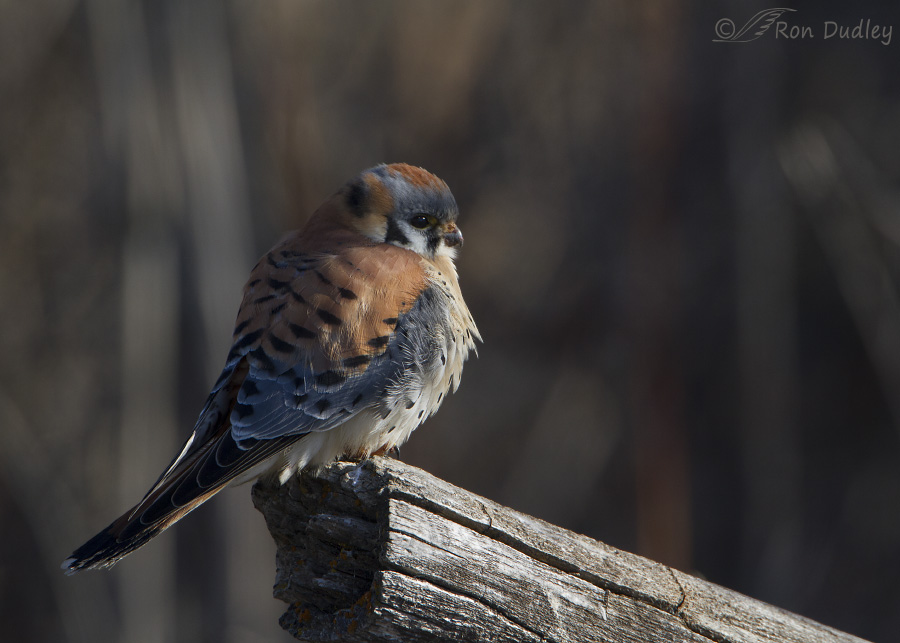
1/1250, f/6.3, ISO 400, Canon 7D, Canon EF 500mm f/4L IS USM + 1.4 tc, not baited, set up or called in
This male was huddled at the base of a clump of trees to escape a fierce wind in front of an incoming storm. He was only inches from the ground where he was a little more protected from the howling gale. Since the wind was blowing overhead branches around, the light on the kestrel was dappled and constantly changing so I just fired away and hoped I’d get some images with interesting light on the bird.
Most everyone loves these fierce little falcons so I hope you enjoy some of these images.
Ron


Thank you so much for these. The one-armed stretch makes me think of the Scarecrow telling Dorothy to go “thataway”.
When I saw the first image, I thought, “Maybe he is practicing for a ballet!” All of these are such interesting shots! I seldom see American Kestrels around here, so really appreciate these photos. For some reason they are as elusive as kingfishers, which I manage to view only on a bridge where there is no stopping! Thanks for sharing these wonderful pictures.
“they are as elusive as kingfishers”
I’ve made that same comparison myself, Jane – most recently in a private message yesterday to one of my blog followers. You and I think alike…
Love them. All.
I also love that their soft and gentle image is so completely wrong. Camoflague of a sort.
Yup, they’re a dichotomy all wrapped up in one little ferocious bird, EC. Thank you.
HAHAHA! What spectacular images, Ron. It’s so very special to wake to your blog. Thank you!
HOWEVER, you made me laugh out loud, almost to the point of spitting my coffee onto the keyboard! I wouldn’t use the word “subtle” for any aspect of female Kestrels beyond their plumage, which of course, was how you used it! Having flown a lovely male Kestrel who was a major sweetheart (but a lethal little heathen monster starling-killing machine when he was hunting) followed by this female (Skye) who is evil incarnate when things don’t go her way 24/7, subtle just isn’t in their lexicon. With her, EPIC hissy fits happen when her world is disrupted.
“Cuddly” is another concept that doesn’t work with them. You can try, but there shall be bloodletting and high discomfort. Like screech owls (and I adore screeches), they just KNOW how to place their talons BETWEEN the joints of your fingers or up underneath your fingernails/cuticles to maximize pain levels. Kinda like my Jack Russell TERRORIST (they’re really misnamed), it requires several strong men to hold them for things like beak coping (trimming). The mere thought of casting (holding) them to cope their beaks sends shudders of terror through the hearts of most well-seasoned falconers.
Of course, I’m joking (mostly, kinda, well NOT!). I adore these micro powerhouses. They’re really special falcons who are bigger than any two golden eagles mashed together and who have the heart of lions. It fills my heart with sorrow that they’re struggling throughout much of their range.
Thanks again for your spectacular images!
Ha, I’ve seen some of your descriptions of Skye’s hissy fits on FB, Laura. That must be one temperamental bird!
And that’s why I used the word “almost” as a modifier for cuddly!
I love how you love your birds.
Ron, I’ve been gifted with an outrageous privilege through falconry. With Skye, it’s all about me being a better staff! For example, she wants to be in her giant hood at sundown. If I show up too late (and we’re talking 30 seconds here), she gives me an ear full, cussing like a sailor. Same if I arrive too early–she just might miss something and that’s bad. I have an alarm on my phone for sunset, updated every day so that I arrive smartly on time. Then, there’s peace in the world…LOL! I adore that diminutive diva!
For a Kestrel who was judged to be unable to fly, she’s flying like an ace pilot! Just gotta find her something to catch!
Love your photos, particularly kestrels and these are just beautiful! My connection to them is quite personal, so everytime I see a post on these beloved birds, not only do I get to engage in your beautiful captures… but it’s another way my brother from up above works his way in saying “hello” to me. Happy Holidays Ron!
I have a similar sentiment about another bird, Julia, so I know what you mean. Several members of my immediate and extended family who have passed away had a particular love for meadowlarks. So when I see or hear those birds I often think of them.
You jest about “bird an a stick” but I’d say these are some of the most interesting birds on a stick I have seen. I love the personalities you have captured in these shots. However I can’t say I have met a kestrel I’d call cuddly. They are the little bird with eagle attitude. Thank you for posting the camera info with your photos. I am finding them very helpful as I learn to use this new Cannon, it has so many new options and menus than my older Nikon DSLR.
I don’t think this one was feeling cuddly either, April – probably far from it. It just gave me that feeling because it was all fluffed up and hunkered down in the rabbitbrush.
I appreciate your comment about including the camera techs. It’s a fair amount of extra work to include them, especially on a long post with many images, so I appreciate knowing that they’re useful to some folks.
Wonderful set of kestrel images Ron. I think my favorite is the third one where you caught the wings at their apex. The first one is also very spectacular with the tail feathers fanned out. I remember a very photogenic male kestrel on the left just as you enter Farmington Bay. On snowy days it would often sit on a post with a small rodent, as if it was showing off. Thanks for the beautiful images of the colorful kestrel !
Lots of folks seem to like that shot with the vertical wings, Ed. And to think I almost didn’t post it because the eye doesn’t have a catch light…
Oooh, a late Christmas gift! Thank you very much!
Wow, it’s a whole box full of beauty and inspiration!
Just what I always wanted.
Happy New Year, y’all!
Thank you, Wally.
Hi1 love this small bird! Great photo’s! I grew up in Michigan and we called them Sparrow Hawks! Looked all the time for them! Never had camera’s when I was growing up! Your photo’s are beautiful! Have a great day Sybill
They were called Sparrow Hawks for many years by a lot of folks, Hummingbird Lover. Just like the Northern Harrier was once called the Marsh Hawk, common names do occasionally change.
With peregrines, the common act of raising both wings above the body is called “warbling”. I’m not sure if that term is used for kestrels as well. Dan
Thanks, Dan. If I remember correctly (and I think I do) this bird didn’t hold the wings in this position – it was actually at the very beginning of take off.
Spectacular images, Ron. Thanx for sharing. Happy New Year!
Thank you, John. Happy New Year to you also.
Ron, you could not have chosen a better subject for a dive into your archives. IMO. Some of these poses are amazing, especially the ones where they are standing on the tip of a vertical branch/stick. I love the big personalities in those small packages, with physical beauty to match. I think my favorite photo in this batch is the ‘one-armed’ wing stretch. Thanks for starting my day out with a smile.
“I love the big personalities in those small packages, with physical beauty to match”
That’s a perfect description, Susan. Throw in the big attitude of these little falcons and you have a simply spectacular bird.
What a visual feast!!! Love the fanned tail, the “hands up!” raised wing shot, and the shot of the biird snuggled into into the soft, downy rabbitbrush…It is surprising to me how often these beautiful little birds perch at the very end such narrow branches and twigs….they can barely fit both feet on them. I wonder why they so often choose these thin, fragile looking places to sit….
“I wonder why they so often choose these thin, fragile looking places to sit”
Some raptors are well known for doing just that, Patty – Rough-legged Hawks for example. If I see a hawk-sized raptor too far off for dependable visual ID perched on a spindly branch at the top of a bush or tree (and if it’s wintertime) I can typically count on it being a roughie instead of a red-tail. Closer inspection through my lens usually confirms it.
Lovely pictures Ron…these lil’ birds are hard to get sharp as they are so small in the frame. Often times, cropping in is needed and that’s when the problems start. It’s interesting to look back and see your settings. From what I can tell, you shoot faster now than when you did back then…is that accurate? Also, it seems to be you closed down the aperture a bit too back then…f/10 on one shot (with no DOF requirement). Natural evolvement of settings over time I would guess yes?
Zaphir, yes I tend to shoot with faster shutter speeds now than I did back then. I may be a slow learner but I eventually figured out what usually works best for my style of shooting.
I used F/10 for that shot for two reasons – I was very close to the bird (so less DOF) and I wanted to get the foreground rabbitbrush as sharp as I could. I prefer not to have blurry elements in front of my subject if possible.
From the way the bird was acting I figured he wasn’t about to take off so I didn’t really need much shutter speed.
All great images Ron! My favorite raptor.
Thank you, Bob.
I just love American Kestrels. Here in Southeast Florida I only see them in the winter. These photos are amazing. It is hard to imagine how cold it must be there. I don’t know a thing about photography lingo so please tell me, what does high key mean?
Kathy, “high key” means the image has a predominance of light or bright tones.
As far as cold goes, were in a heat wave right now – at the moment it’s 24 degrees F.
These are some great shots! Love the look of pure bliss, contentment as he grooms his tail feathers.
Wonderful show, thanks for sharing.
“Love the look of pure bliss, contentment as he grooms his tail feathers”
He must have been feeling just that, Dick, because he sure worked those tail feathers over for a long time. Thank you.
Love the pictures. And the different spot patterns on the males.
Those male colors and patterns are pretty neat, aren’t they, Sallie.
A gorgeous elusive bird, magnificently photographed Ron!
Charlotte
Thanks very much, Charlotte.
They are a lovely bird and you’ve shown a range of behaviors in these photo’s – wonderful morning entertainment, Ron.
Thanks, Judy – always happy to oblige!